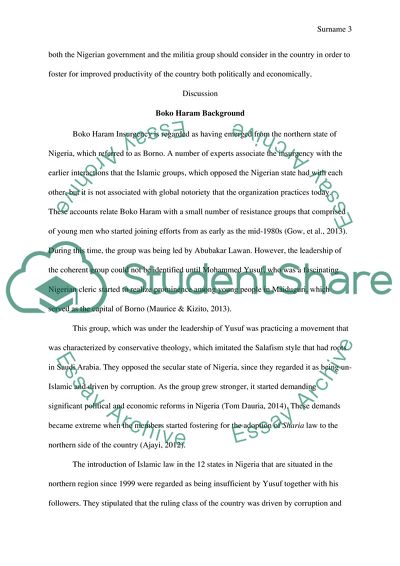Cite this document
(Boko Haram Insurgency Essay Example | Topics and Well Written Essays - 2500 words, n.d.)
Boko Haram Insurgency Essay Example | Topics and Well Written Essays - 2500 words. https://studentshare.org/politics/1815939-provide-an-in-depth-analysis-of-a-current-conflict-using-the-participatory-conflict-analysis-tools-introduced-in-this-module-session-6-7-based-on-your-analysis-identify-the-strengths-and-weaknesses-of-the-tools-you-used-and-identify-key-issues-that-ne
Boko Haram Insurgency Essay Example | Topics and Well Written Essays - 2500 words. https://studentshare.org/politics/1815939-provide-an-in-depth-analysis-of-a-current-conflict-using-the-participatory-conflict-analysis-tools-introduced-in-this-module-session-6-7-based-on-your-analysis-identify-the-strengths-and-weaknesses-of-the-tools-you-used-and-identify-key-issues-that-ne
(Boko Haram Insurgency Essay Example | Topics and Well Written Essays - 2500 Words)
Boko Haram Insurgency Essay Example | Topics and Well Written Essays - 2500 Words. https://studentshare.org/politics/1815939-provide-an-in-depth-analysis-of-a-current-conflict-using-the-participatory-conflict-analysis-tools-introduced-in-this-module-session-6-7-based-on-your-analysis-identify-the-strengths-and-weaknesses-of-the-tools-you-used-and-identify-key-issues-that-ne.
Boko Haram Insurgency Essay Example | Topics and Well Written Essays - 2500 Words. https://studentshare.org/politics/1815939-provide-an-in-depth-analysis-of-a-current-conflict-using-the-participatory-conflict-analysis-tools-introduced-in-this-module-session-6-7-based-on-your-analysis-identify-the-strengths-and-weaknesses-of-the-tools-you-used-and-identify-key-issues-that-ne.
“Boko Haram Insurgency Essay Example | Topics and Well Written Essays - 2500 Words”. https://studentshare.org/politics/1815939-provide-an-in-depth-analysis-of-a-current-conflict-using-the-participatory-conflict-analysis-tools-introduced-in-this-module-session-6-7-based-on-your-analysis-identify-the-strengths-and-weaknesses-of-the-tools-you-used-and-identify-key-issues-that-ne.


